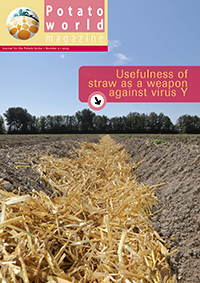Already a subscriber? Activate your premium account

Potatoworld Magazine

During the Potato Variety Days 2021, we asked participating breeding companies about the key focus of their breeders in their search for new varieties. In this blog post you may read the answer given by Tigran Richter, Managing Director of Norika, Sanitz (D):
The content of this blog originates from the article on the Potato Variety Days 2021 published in PotatoWorld magazine 2022/01.
By Zindziwe Janse, Jaap Delleman and Leo Hanse.
‘Norika is a full portfolio breeder, we develop for all market segments in both processing and table potatoes and deal with specific breeding targets for each segment. In addition, there are, of course, general targets that effect our entire portfolio’, explains Tigran Richter.
Richter, who is Managing Director of Norika, sees that, as far as general interests are concerned, public opinion is playing an increasingly important role. ‘Both in society and in politics, discussions are taking place about what a more sustainable future should look like. We all understand by now that change is necessary, but the farming community is concerned that as a result of expectations from society, politicians will make demands that can’t be met. Political decisions are usually taken within a short time period, and usually for the next year or for the next harvest, while it takes about 12 to 15 years to get a suitable potato variety on the market when the traditional breeding system is used’, he says, expressing the concerns of the growers. Every link in the value chain, according to Richter, is part of the answer to the durability question. ‘The breeder community can contribute by breeding potato varieties that better meet the requirements. They must be more resistant to stress, need less input in terms of fertiliser and perhaps also water, have resistance in order to reduce or even avoid the use of chemicals, and ultimately offer the grower a safe income base’, the Managing Director explains. In principle, everyone is in agreement that less fertiliser should be used’, says Richter. ‘Growers understand that from a political and economic point of view. Of the so-called low-input varieties that are suitable for this, we already have about three or four table potato varieties. It wasn’t very easy to get them introduced though. If we’d asked a grower five years ago to halve the nitrogen content, he’d have thought that we were joking, because with no nitrogen there’s no yield, right? It’s becoming more and more expensive nowadays and we’re now getting the question: “What was that variety again that grows so well with half the nitrogen?”’, Richter says with a laugh. As a sustainable example, he mentions the Soraya table potato variety. ‘This variety fits into the programme of low-input varieties, with a lower nitrogen use.’
Want to keep reading about the Potato Variety Days?
In the run-up to the event we published an e-book that you can download here!
Events
©2015 - 2024 Potatoworld | Webdesign and realisation COMMPRO